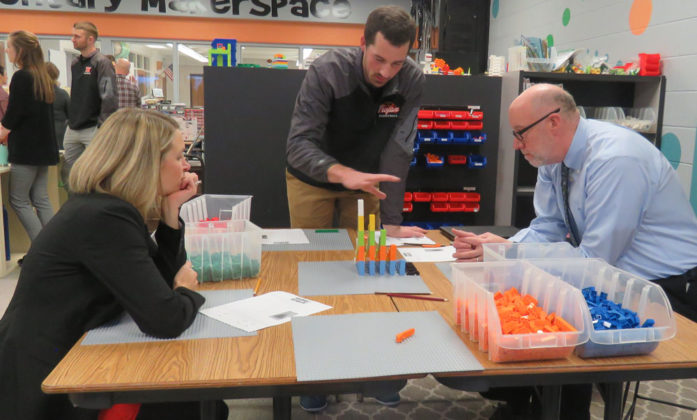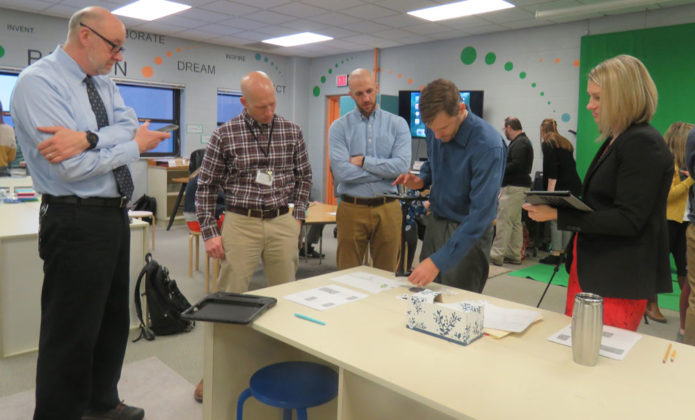The makerspace room at Lee Elementary was the star of the show when visitors from East Grand Rapids Schools came to Middleville.
While Thornapple Kellogg students stacked Lego pieces to represent different fractions and used littleBits to turn wheels and demonstrate sample circuits, Doug Jenkins, East Grand Rapids director of Technology and Assessment, and Wealthy Elementary School Principal Carlye Allen were taking notes for their district.
“The physical learning and the enjoyment you see is wonderful,” Jenkins said. “The kids are standing up or working at stations. Their creativity comes to life and it’s a great place to encourage student engagement.”
East Grand Rapids administrators said they are considering creating their own makerspace room, but wanted to visit schools to see how the room functions and what works best.

Making Room for Creativity
Makerspace meets many needs of the STEAM (science, technology, engineering, arts and math) learning process popular in public schools. Lee’s makerspace allows students to tear things apart in the deconstruction zone to understand how they work; Skype with students around the world; make videos; and turn their ideas into models with a 3-D printer. Many teachers have their classes use Legos to work on math problems, cardboard to create projects, or crayons and markers to build and design.
Lee’s makerspace was created in 2017 using space once occupied by a now outdated computer lab. Since then, it’s been a place of hands-on learning, experiments and creativity. The space was renovated through grants, fundraising and community donations.
Lee Principal Angela Jefferson said it’s a wonderful place for students to get their hands on blocks and Legos, dive into creativity and think outside the box.
“We love our makerspace room and what it can do for our students,” she said. “Our teachers continue to find ways to incorporate lessons with hands-on learning in makerspace.”
Source of Inspiration
Allen found inspiration during the Lego math demonstration.
“This Lego math lesson is so visual,” she said. “I can see it being very helpful for our students.”
Third-grade teacher Josh Thaler said using the Legos for different math lessons is easier for some students.
“They can see the fractions or the addition and subtraction,” he said.
Lee combined the guest visit with a professional development hour for teachers to receive a refresher course on how makerspace can enhance classroom curriculum.
Second-grade teacher Nathan Fischer demonstrated the llttleBits where circuits turned on lights for a quiz board. Technology Director John Dombrowski showed how student writing comes to life in film. Fellow Technology Director Angie Ruger showed how to incorporate video production with writing assignments, social studies and science.
Words in Action
After the teacher training, the EGR visitors stayed to watch Fischer’s students actively engaged in the makerspace area.
Students grouped KEVA Planks in different combinations to easily count out 100 of them. Some made piles of 10 while others made piles of five. Some came up with other methods. Students were then challenged to use their creativity and engineering skills to build the tallest structure they could using all 100 planks. A second task asked them to work with a partner to create two structures connected by a bridge.
Students with the KEVA Planks were spread out all around the room — on the tables and the floor, with plenty of room for students to walk around and see what others had done.
Fischer said he uses the room with his students often.
“They love it,” he said. “They would come in here every day if they could. It’s just a great place for them to be creative and have hands-on learning.”
CONNECT












